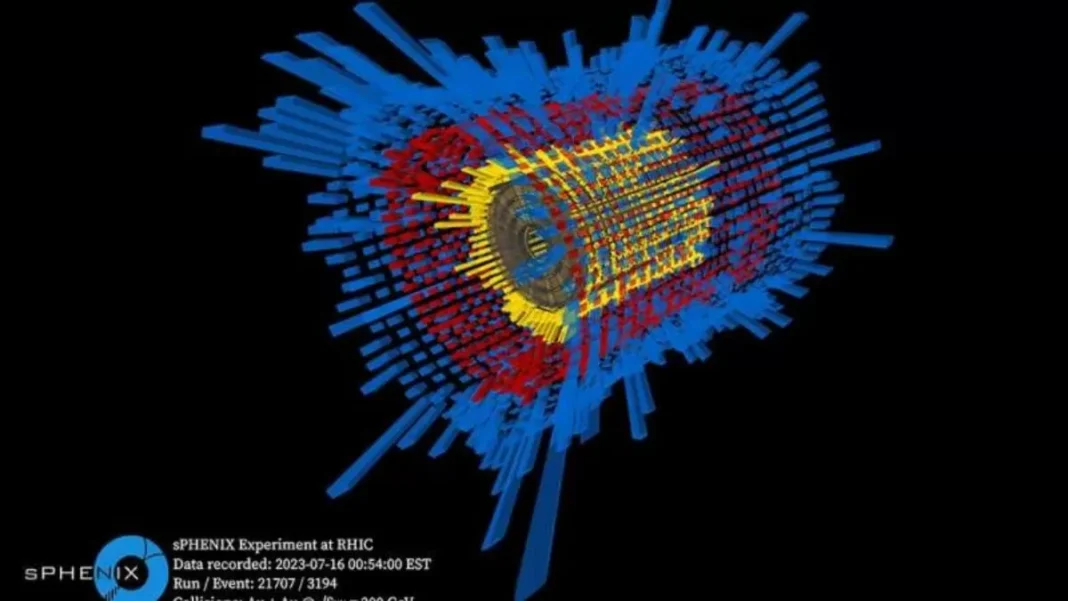Brookhaven National Laboratory’s sPHENIX detector, located at the Relativistic Heavy Ion Collider (RHIC), has recently released its first results from gold-ion collisions. These results confirm the detector’s accurate detection of particle counts and energy levels, marking a significant milestone in the field of nuclear physics.
The sPHENIX detector is a state-of-the-art instrument designed to study the properties of the quark-gluon plasma (QGP), a unique form of matter that existed in the early universe, just microseconds after the Big Bang. This primordial state of matter is believed to hold the key to understanding the fundamental laws of nature and the evolution of the universe.
The first results from the sPHENIX detector, published in the journal Physical Review Letters, demonstrate the detector’s exceptional performance in detecting and measuring particles produced in high-energy collisions. These collisions recreate the extreme conditions that existed in the early universe, allowing scientists to study the behavior of matter under such extreme conditions.
One of the key findings of the study is the accurate detection of particle counts and energy levels. This is crucial for understanding the behavior of the QGP, as it provides valuable information about the density and temperature of the matter created in these collisions. The sPHENIX detector’s precise measurements have validated its performance and have laid the groundwork for future studies of the QGP.
The sPHENIX detector is a significant upgrade to the PHENIX detector, which has been in operation at RHIC since 2000. It is equipped with advanced technologies and state-of-the-art detectors, making it one of the most sophisticated instruments in the world for studying the QGP. The detector’s capabilities have been enhanced by the addition of a new electromagnetic calorimeter, which measures the energy of particles produced in the collisions.
The successful operation of the sPHENIX detector is a testament to the hard work and dedication of the team of scientists and engineers at Brookhaven National Laboratory. They have spent years designing, building, and testing the detector to ensure its accuracy and reliability. The first results from the detector are a testament to their efforts and a significant achievement for the field of nuclear physics.
The data collected by the sPHENIX detector will serve as a baseline for future studies of the QGP. By comparing the results from different collision energies and systems, scientists hope to gain a deeper understanding of the properties of the QGP and its evolution. These studies will provide valuable insights into the early universe and help us unravel the mysteries of the fundamental laws of nature.
The sPHENIX detector’s first results have also opened up new avenues for research. The detector’s capabilities can be further enhanced by incorporating new technologies and upgrades, allowing scientists to explore the QGP in even greater detail. This will pave the way for groundbreaking discoveries and advancements in the field of nuclear physics.
The success of the sPHENIX detector at RHIC is a testament to the importance of collaboration and international partnerships in scientific research. Scientists from around the world have come together to work on this project, bringing their expertise and knowledge to achieve a common goal. This collaboration has not only led to the development of a world-class detector but has also fostered a spirit of cooperation and exchange of ideas among scientists.
In conclusion, the first results from the sPHENIX detector at RHIC have confirmed its accurate detection of particle counts and energy levels, validating its performance and laying the groundwork for future studies of the QGP. This is a significant achievement for the field of nuclear physics and a testament to the hard work and dedication of the team at Brookhaven National Laboratory. With the baseline data established, scientists can now delve deeper into the mysteries of the early universe and unlock the secrets of the fundamental laws of nature. The sPHENIX detector is a shining example of the power of scientific research and international collaboration, and its future looks bright with endless possibilities for groundbreaking discoveries.


